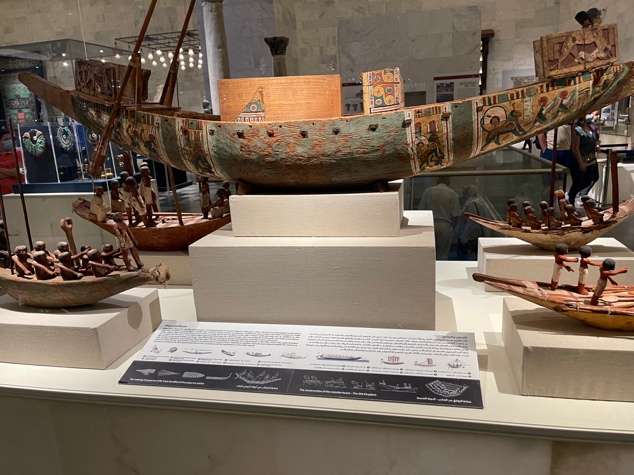Introduction
The visit to the National Museum of Egyptian Civilization was a great addition to the themes learned in class. The observed artifacts demonstrate the peculiarities of life and culture of the Egyptian people. Many contain a fascinating story that opens the door to Egyptian history and civilization formation. This paper examines one of the artifacts – boats and ships – and their role in Ancient Egyptian society.
Artifact Description


I took these photos in the National Museum of Egyptian Civilization (Fig.1). The first image illustrates an artifact called “Ships and Boat.” The observer can see a large wooden ship in the middle and four small boats around. The boats are clearly driven by slaves who row the oars under the guidance of their leaders. Obviously, each boat has its own purpose since it can be seen that the crew is busy with various activities. In addition, the configuration and painting of the boats also differ. The central ship, meanwhile, is much more beautiful and more decorated. Based on the description of the artifact, it could probably be The Royal Bark of Amenhotep II of the 18th Dynasty (Fig. 2).
Artifact’s Relation to Ancient Egyptian History and Society
First of all, as mentioned above, the artifact is most likely related to the 18th Dynasty, thus, dating back to 1400 BC, the era of the New Kingdom (1549 – 1069 BC) (Ikram 98). As we remember from classroom readings, Amenhotep II was the New Kingdom’ seventh pharaoh and was known for his athletic achievements. Being the son and successor of Thutmose III, he also continued his father’s expansionary policy (Ikram 99). As we know, ships played an important role in military affairs, helping to expand the kingdom’s territory. Thus, the boat model is part of the accessories for the tomb of the pharaoh.
In general, such importance was attributed to boats and ships due to their massive role in the development of Ancient Egypt. They helped transport trade goods and building materials for the unique Egyptian architecture (Ikram 12). Considering the central place of the Nile in the geopolitical structure of the country, boats and ships, as an artifact, demonstrate an integral part of the culture of ancient Egypt.
The artifact also recalls the very first discussions when we talked about the role of the Nile in the development of Ancient Egyptian civilization. Literally, as the cradle of society, the Nile laid the foundation not only for the trade, economic and agricultural successes of the Egyptians but also gave birth to the theological ideas of the people (Ikram 9). That is why ships and boats have not only practical but also sacred meanings. It was believed that in the other world, there was a celestial river, along which spirits floated on their way to resurrection, and the gods traveled. Since in the Ancient Egyptian worldview, the pharaoh has a divine essence, in the afterlife, the ruler, like a god, will move on his ship along the river (Silverman 180). Overall, the artifact is precious in terms of reconstructing various perspectives of Ancient Egyptian society.
Works Cited
Ikram, Salima. Ancient Egypt: An Introduction. Cambridge: Cambridge University Press, 2010.
Silverman, David. Ancient Egypt. Cairo: AUC Press, 1999.